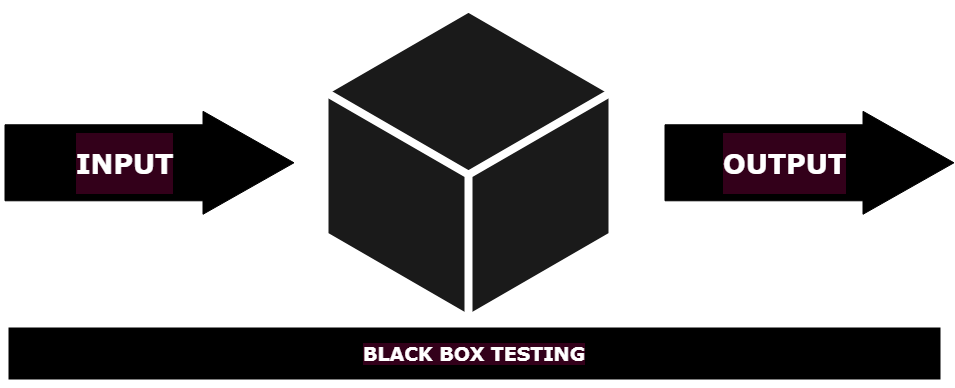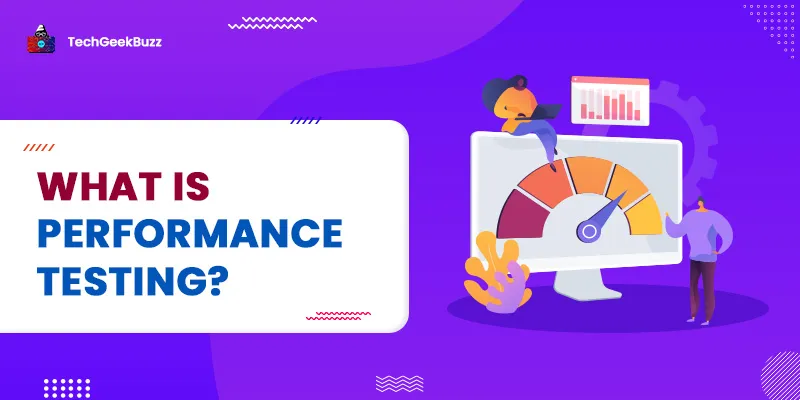It refers to a technique of testing by which application under test (AUT) functionality is tested without any internal code structure, details, knowledge, and implementation of internal ways of the software.
Black box testing is completely based on software demands and specifications. In this type of testing, we have to focus on the input and output of a software system without worrying about the internal information of the software program. There are various parameters that are checked in the black box testing, so these parameters are:
- Precise activities performed by users
- Framework's communication with the data sources
- The reaction time of the framework
- Utilization of information structures Issues in the user interface
- Issues in usability
- Execution issues
- Unexpected application failure, unfit to begin or finish

Black Box Testing Process
The process of black-box testing follows specific steps for achieving the desired results, so these steps are:
- First, testers examine the requirements and specifications of a system.
- After obtaining appropriate data, testers select valid input to check the SUT processes them accurately. Apart from it, the negative test scenario is selected to verify that the SUT can detect them.
- Now, testers discover the expected outputs for all of the inputs.
- A software tester creates test cases with all selected inputs.
- Testers start to execute the test cases.
- The software tester matches the actual and expected outputs.
- In case the tester finds any defects, then the system is retested for accurate results.
Software Development Life Cycle (SDLC) of Black Box Testing:
Black box testing holds the life cycle, which is known as Software Testing Life Cycle (STLC). It is relevant to each stage of the Software Development Life Cycle of Software Engineering:
- Requirement: It is an opening stage of SDLC, so a requirement is gathered in this particular stage and a software tester also takes part in this stage.
- Test Planning & Analysis: In this stage, Testing Types appropriate to the project are determined. A Test Plan is generated, which defines possible project risks and their reduction.
- Design: Test cases/scripts are generated in this stage, and it is based on software requirement documents.
- Test Execution: Prepared test Cases are executed in this stage. Bugs, if any, are fixed and re-tested.
Types of Black Box Testing
Black box testing consists of various types, so let's discuss the types of Black Box Testing in brief:
- Regression testing: It is done after fixing, upgrading codes, or after the maintenance of other systems to check the new code has not affected the existing code.
- Functional testing: It is related to all functional requirements of the system, and it is done by software testers.
- Non-functional testing: It is not related to testing of specific functionality but non-functional requirements such as performance, scalability, and usability.
Techniques of Black Box Testing
There are appropriate techniques of black box testing because these include prominent Test Strategies, so let's discuss all techniques in brief:
- Boundary Value Testing: It focuses on the conditions at boundaries. This technique defines whether a particular range of values is adequate by the system or not. It is very helpful in decreasing the number of test cases. It is most proper for systems where input is within specific ranges.
- Equivalence Class Testing: This technique is used to minimize the number of possible test cases to an excellent level while maintaining consistent test coverage.
- Decision Table Testing: A decision table holds reasons and their results in a matrix. There is an individual combination in a particular column.
- State Transition Testing : This testing procedure utilizes the inputs, outputs, and the state of the framework during the testing stage. It checks the product against the arrangement of advances or occasions among the test information. Because of the kind of programming that is tried, it checks for the conduct changes of a framework in a specific state or another state while keeping up similar inputs.
- Graph-Based Testing: It is like a choice-based experiment configuration approach where the connection among connections and input cases are thought of.
- Comparison testing: This technique utilizes two distinct renditions of similar programming to think about and approve the outcomes.
- Error Guessing Technique: This technique for structuring experiments is tied in with speculating the output and input to fix any blunders that may be available in the framework. It relies upon the aptitudes and judgment of the tester.
Black Box testing tools
Tools for Black box testing are entirely based on the type of black-box testing is required:
- For functional or regression tests: For this type of testing, the tester can use QTP, Selenium
- For Non-Functional Tests: For this type of testing, the tester can use LoadRunner, Jmeter
Difference between black box and white box testing
| Black Box testing | White Box testing |
| It focuses on the validation of the functional requirements. | It proves internal structure as well as working of your software code |
| It provides an abstraction from the code and concentrates on the testing effort on the software system behavior. | For conducting White Box Testing, you need knowledge of programming languages. Current-day software systems use a type of programming language and technologies, and it's not reasonable to know all of them. |
| It helps in testing communication amongst modules. | It does not help with testing communication among modules. |
| Test cases are based on the required specification. | It requires a detailed design for test cases. |
Benefits of Black box testing
- Tests are done from a user's perspective and will help in uncovering disparities in the particulars.
- Testers are not required to have knowledge of programming languages or how the product has been actualized.
- Tests can be led by a body autonomous from the developers, taking into consideration a target point of view and the evasion of developer-predisposition.
- Experiments can be planned when the particulars are finished.
Limitations of Black box testing
- Just a few potential information sources can be tried, and many program ways will be left untested.
- Without precise determinations, which are the circumstance in numerous projects, experiments will be hard to plan.
- Tests can be excessive if the product creator/developer has just run an experiment.
Conclusion
As we know that black box testing refers to a technique of testing by which application under test (AUT) functionality is tested without any internal code structure, details, knowledge, and implementation of internal ways of the software.
In this article, we have discussed White Box Testing completely regarding the overview, process, types, and tools so that you can understand every aspect of this testing.
People are also reading:



![What is Waterfall Model? [Phases, Pros, & Cons]](/media/new_post_images/Waterfall_Model.webp)

Leave a Comment on this Post